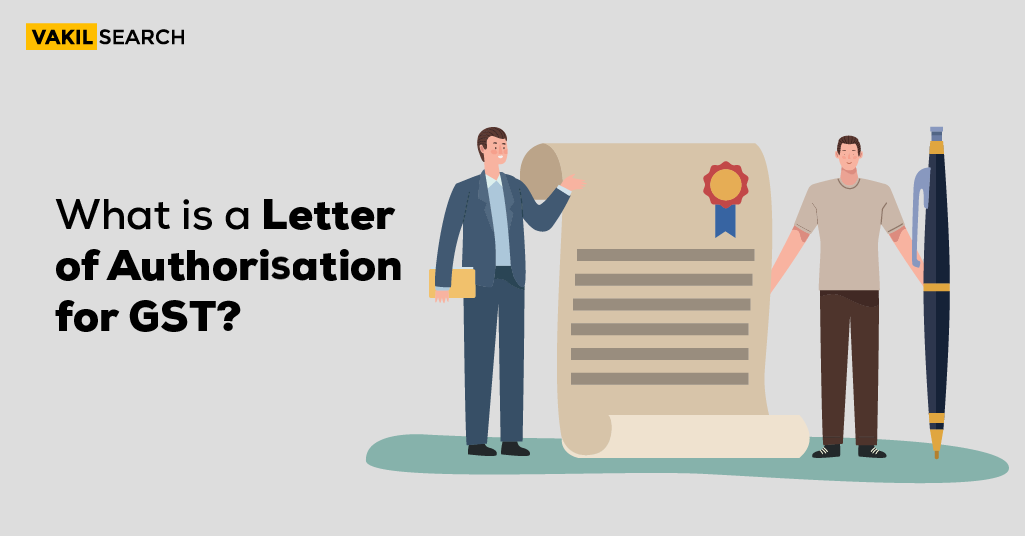Explore the critical role of a Letter of authorisation for GST, its components, types, and the efficiency it brings to compliance processes.
Introduction
In the dynamic landscape of Goods and Services Tax (GST) compliance, understanding the various documents and authorisations is paramount. Among these, the Letter of authorisation (LOA) holds a distinctive place. This article delves into the intricacies of a Letter of authorisation for GST, shedding light on its purpose, components, and the pivotal role it plays in the business realm.
What is a Letter of Authorisation for GST?
A Letter of authorisation for GST is a formal document that grants an individual or entity the legal authority to act on behalf of another in matters related to GST compliance. It establishes a clear framework for representation and ensures that the authorised entity can perform specific actions on behalf of the principal, streamlining GST processes.
Components of a Letter of Authorisation
-
Identification Details
The LOA begins with comprehensive identification details of both the principal and the authorised entity. This includes names, addresses, and GSTIN (Goods and Services Tax Identification Number) details, establishing a clear understanding of the entities involved.
-
Purpose of Authorisation
Clearly stating the purpose of authorisation is crucial. Whether it’s filing GST returns, responding to inquiries, or representing the principal in GST matters, specifying the purpose ensures that the authorised entity’s actions align with the principal’s intentions.
-
Scope of Authority
Defining the scope of authority explicitly outlines the actions the authorised entity can undertake. This may include filing returns, responding to notices, or handling specific GST-related transactions. A well-defined scope avoids ambiguity and sets clear boundaries.
Types of Letters of Authorisation
Limited Authorisation
In certain scenarios, a principal may grant limited authorisation for specific GST-related activities. This type of LOA restricts the authorised entity to particular actions, providing a nuanced approach based on the principal’s requirements.
General Authorisation
A general authorisation grants broader powers, allowing the authorised entity to handle a range of GST activities on behalf of the principal. This is often preferred for comprehensive representation in routine GST compliance matters.
Legal Validity and Compliance
Adhering to Legal Standards
Ensuring that the Letter of authorisation adheres to legal standards is imperative. This involves complying with GST regulations, using the prescribed format, and including all necessary details to make the document legally valid.
Verification by GST Authorities
Once an LOA is in effect, GST authorities may verify its authenticity. Providing accurate information and complying with legal standards ensures a smooth verification process, preventing potential disruptions in GST-related activities.
Process of Obtaining a Letter of Authorisation
Drafting the LOA
The initial step involves drafting the LOA, which should be a meticulous process. Clearly articulate the purpose, scope, and identification details to avoid any misunderstandings in the future.
Consent of Both Parties
Obtaining the consent of both the principal and the authorised entity is crucial. This ensures that both parties are in agreement with the terms and conditions laid out in the LOA.
Notarisation
While not mandatory, notarising the LOA adds an extra layer of authenticity. notarisation involves the certification of the document by a notary public, further solidifying its legal standing.
Submission to GST Authorities
The final step involves submitting the duly signed and notarised LOA to the GST authorities. This may be done through online portals or physical submission, depending on the prevailing regulations.
Common Misconceptions about Letters of Authorisation
Automatic GST Compliance
Contrary to a common misconception, having an LOA doesn’t automatically ensure GST compliance. The authorised entity must still adhere to GST regulations and perform actions in alignment with the principal’s intentions.
Permanent authorisation
An LOA doesn’t necessarily grant permanent authorisation. Principals may specify a limited duration or include conditions that determine the period of validity, providing flexibility in authorisation terms.
Importance of a Letter of Authorisation in Business
Delegating Responsibilities
A well-crafted LOA allows principals to delegate specific GST responsibilities to trusted entities. This delegation is crucial for effective business operations, especially when dealing with the complexities of GST compliance.
Efficient GST Processes
By streamlining the representation process, an LOA contributes to the efficiency of GST-related activities. Authorised entities can promptly respond to notices, file returns, and handle inquiries, reducing the burden on the principal.
Risk Mitigation
The LOA serves as a risk mitigation tool. Principals can define the scope and limitations, reducing the risk of unauthorised actions and ensuring that GST-related matters are handled with precision and under regulations.
Challenges in Using Letters of Authorisation for GST
Revocation Issues
In some cases, principals may face challenges when attempting to revoke an LOA. Clear provisions for revocation and understanding the legal implications are essential to mitigate such challenges.
Unauthorised Actions
Misuse of an LOA, leading to unauthorised actions by the authorised entity, poses a potential challenge. Strict monitoring and periodic reviews can help address this concern.
Conclusion
In conclusion, a Letter of authorisation for GST is a powerful instrument that facilitates seamless representation in the complex world of GST compliance. By understanding its components, types, and legal implications, businesses can harness the benefits of efficient delegation. Leveraging the LOA not only streamlines processes but also contributes to risk mitigation and effective governance. As businesses continue to navigate the intricate landscape of GST, a well-structured and legally sound Letter of authorisation emerges as a strategic asset, ensuring that the wheels of GST compliance turn smoothly for all parties involved.
Vakilsearch, a leading provider of legal services, plays a pivotal role in this process. With their expertise in legal documentation and compliance, Vakilsearch can assist businesses in drafting comprehensive Letters of authorisation that align with regulatory standards. By availing Vakilsearch’s services, businesses can navigate the complexities of GST regulations with confidence, ensuring that their Letters of authorisation are not only efficient but also strategically crafted for effective governance and risk management.
FAQs
What is the primary purpose of a Letter of authorisation for GST?
The primary purpose of a Letter of authorisation for GST is to grant legal authority to an individual or entity, allowing them to act on behalf of another in matters related to Goods and Services Tax compliance, such as filing returns and responding to inquiries.
What information is crucial in the identification details section of an LOA for GST?
The identification details section should include comprehensive information about both the principal and the authorised entity, such as names, addresses, and GSTIN (Goods and Services Tax Identification Number) details, establishing a clear understanding of the entities involved.
Can a Letter of authorisation for GST be limited to specific activities?
Yes, a principal can grant limited authorisation for specific GST-related activities. This type of LOA restricts the authorised entity to particular actions, providing a nuanced approach based on the principal's requirements.
Is notarisation mandatory for a Letter of authorisation for GST?
Notarisation is not mandatory, but it adds an extra layer of authenticity. While not strictly required, notarising the LOA involves the certification of the document by a notary public, further solidifying its legal standing.
How does a Letter of authorisation contribute to risk mitigation in GST compliance?
The LOA serves as a risk mitigation tool by allowing principals to define the scope and limitations of the authorised entity. This reduces the risk of unauthorised actions, ensuring that GST-related matters are handled with precision and in accordance with regulations.










